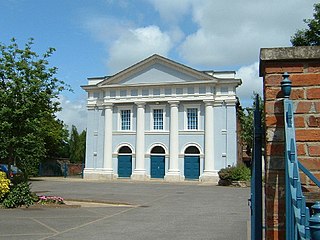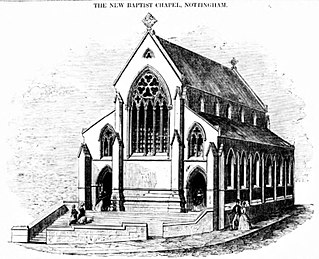



John Thomas Emmett (18 August 1823 - 3 August 1898) was an English architect and designer based in London. [1]




John Thomas Emmett (18 August 1823 - 3 August 1898) was an English architect and designer based in London. [1]
He was born on 18 August 1823, the son of John Emmett and Mary Saunders.
By 1846 he was working in practice at 11 Beaufort Buildings in London. By 1868 he was at 1 Cloudesley Square, Islington in London. In 1857 he was declared bankrupt., [2] but by 1865 was a director of the North London, Highgate and Alexandra Park Railway. [3]
He was a devotee of the Gothic style of architecture, and unafraid to criticise his colleagues building in more contemporary styles. In 1872 he published an anonymous article in the Quarterly Review on "The state of English architecture" [4] which drew attacks from other architects.

William Butterfield was a Gothic Revival architect and associated with the Oxford Movement. He is noted for his use of polychromy.

Sir George Gilbert Scott, known as Sir Gilbert Scott, was a prolific English Gothic revival architect, chiefly associated with the design, building and renovation of churches and cathedrals, although he started his career as a leading designer of workhouses. Over 800 buildings were designed or altered by him.

Sir Samuel Morton Peto, 1st Baronet was an English entrepreneur, civil engineer and railway developer, and, for more than 20 years, a Member of Parliament (MP). A partner in the firm of Grissell and Peto, he managed construction firms that built many major buildings and monuments in London, including The Reform Club, The Lyceum, Nelson's Column and the new Houses of Parliament; which made him a millionaire.

Philip Hardwick was an English architect, particularly associated with railway stations and warehouses in London and elsewhere. Hardwick is probably best known for London's demolished Euston Arch and its twin station, the original Birmingham Curzon Street, which stands today as the oldest railway terminus building in the world.
Samuel Sanders Teulon was a 19th-century English Gothic Revival architect, noted for his use of polychrome brickwork and the complex planning of his buildings.

Blythswood Hill, leading to Blythswood Square, is one of the central hills overlooking the River Clyde, which form the city of Glasgow, Scotland, and was developed as one of its prestigious residential areas from 1800 onwards, being known then as ″the magnificent New Town of Blythswood″. After the Reformation the Lands of Blythswood were owned by the distinguished Glasgow merchant family Elphinstone, whose last descendant George Elphinstone became an MP of the Scots Parliament. Through his daughter it changed to the Douglas-Campbell family during the 17th century. Archibald Campbell, whose son became Lord Blythswood, setting about feuing the lands to developers.
John Burnet was a Scottish architect who lived and practised in Glasgow. He was born the son of soldier and trained initially as a carpenter, before becoming a Clerk of Works. He rose to prominence in the mid-1850s.
Samuel Whitfield Daukes (1811–1880) was an English architect, based in Gloucester and London.

Dissenting Gothic is an architectural style associated with English Dissenters, that is, Protestants not affiliated with the Church of England. It is a distinctive style in its own right within Gothic Revival architecture that emerged primarily in Britain, its colonies and North America, during the nineteenth century.

John Tarring FRIBA (1806–1875) was an English Victorian ecclesiastical architect active in the mid-nineteenth century. Based in London, he designed many Gothic Revival churches for Nonconformist clients.
John Wills was an architect based in Derby.

Matthew Edward Habershon, known as Edward Habershon, was an architect practising in London and south-east England. He specialised in neo-gothic buildings, especially churches and chapels. With his brother W.G. Habershon he designed St John the Baptist's Church, Hove, now a Grade II building. With E.P.L. Brock he designed a number of churches including St Leonards-on-Sea United Reformed Church, also listed at Grade II. He designed St Andrews church in Hastings, where Robert Tressell's large mural was created. In 1862 he was involved in the relocation of London's burial grounds, moving more than one thousand hundredweight of human remains.

Richard Bond (1798–1861) was an early American architect who practiced primarily in Boston, Massachusetts.
William Wigginton (1826–1890) was an English architect. Born in Eton, Berkshire, he worked in Derby and Dudley before moving to London in 1860. He published proposals for working-class housing, and designed several Gothic Revival churches in London, often featuring polychrome brickwork.
Samuel Groves was a British organ builder based in London.

John Davies (1796–1865) was an architect who trained in London under George Maddox, an architect who specialised in classical buildings. Davies began to exhibit at the Royal Academy in 1819 and travelled to Italy in 1820–21. He appears to have been a competent artist and Luigi Rossini engraved a drawing by him of the Temples of Paestum. He was a Fellow of the Royal Institute of British Architects. He served as District Surveyor to Tower Hamlets from 1839 until his death in 1865.
Frederick Barnes (1814–1898) was a British architect who is best remembered for his work on railway stations in East Anglia.

George Woodhouse was an English architect who practised from offices in Bolton, and Oldham, then in the county of Lancashire. He collaborated with William Hill on the designs for Bolton Town Hall.
Alfred Hill Thompson, ARIBA was an English architect in the Gothic Revival and Arts and Crafts styles, who specialised in small schools and chapels in the Yorkshire area. In partnership with Isaac Thomas Shutt he co-designed the Church of All Saints, Harlow Hill, completed in 1871.

William Booker was an English architect based in Nottingham.
| Wikisource has original text related to this article: |